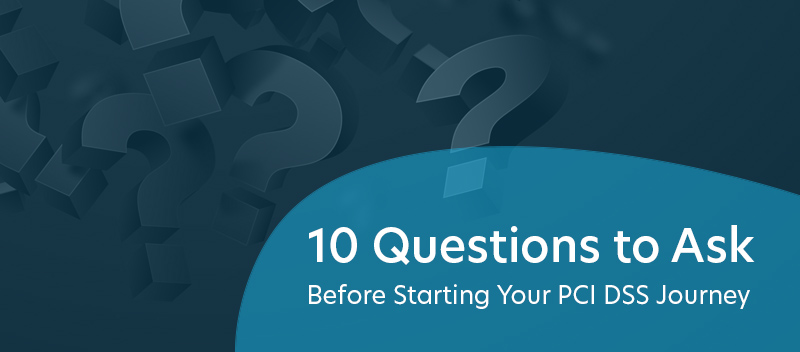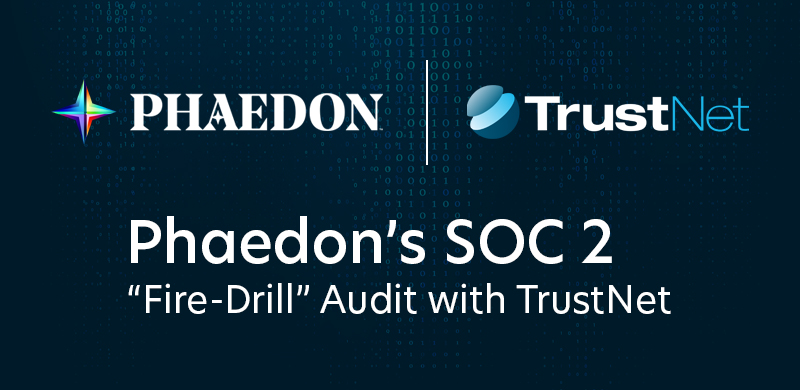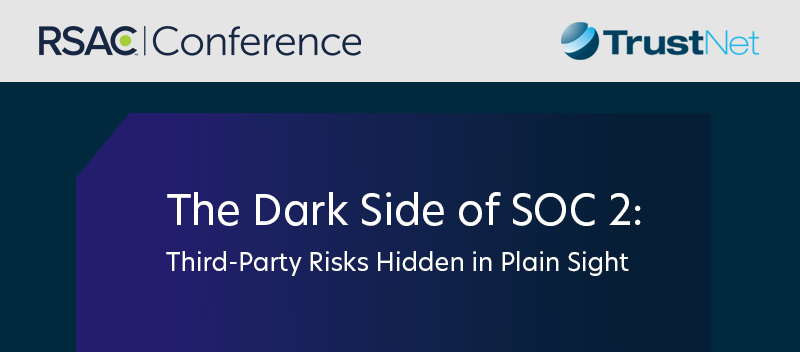10 Questions to Ask Before Starting Your PCI DSS Journey

Achieving PCI DSS compliance is essential for safeguarding cardholder data, meeting industry standards, and minimizing risks. Being prepared is necessary whether you are embarking on your first assessment or refining your approach. This guide outlines 10 key questions to ask before starting your PCI DSS compliance journey.
-
- What is our current PCI DSS compliance level?
- What is the scope of our cardholder data environment?
- Do we have a dedicated team for PCI DSS compliance?
- What is our current security posture?
- What documentation do we need to prepare?
- How will we manage third-party service providers?
- What is our timeline for achieving compliance?
- How will we handle incident response and breach notification?
- What technologies do we need to implement or upgrade?
- How will we maintain compliance long-term?
Each one offers insights to help you build a robust compliance strategy and leverage TrustNet’s Accelerator+ approach for streamlined PCI compliance success.
1. What is our current PCI DSS compliance level?
Understanding your PCI DSS compliance level is crucial for defining your organization’s compliance roadmap. At TrustNet, we specialize in assessing your current status and helping you align with the right requirements. Your annual transaction volumes determine compliance levels:
-
- Level 1: Over 6M transactions/year
- Level 2: 1–6M transactions/year
- Level 3: 20K–1M transactions/year
- Level 4: Fewer than 20K transactions/year
For service providers, the levels are based on cardholder data interactions:
-
- Service Provider Level 1: Over 300K transactions/year
- Service Provider Level 2: Fewer than 300K transactions/year
TrustNet’s PCI Accelerator+ Program guides this classification through a structured approach. We identify your transaction volume, determine your compliance level, and clarify the specific requirements applicable to your organization.
2. What is the scope of our cardholder data environment (CDE)?
Your cardholder data environment (CDE) includes all systems that store, process, or transmit cardholder data, making it essential to accurately identify and document these components. Mapping data flows within your organization helps uncover how cardholder data moves and where potential vulnerabilities might exist.
At TrustNet, we specialize in conducting comprehensive scoping exercises to streamline compliance efforts. Our approach includes:
-
- Identifying all systems that store, process, or transmit cardholder data
- Mapping data flows to provide a clear understanding of your data’s movement
- Offering network segmentation solutions to reduce scope and enhance security
By narrowing your CDE scope wherever possible, we help you focus on the most critical areas, reducing the complexity and cost of compliance while improving overall data protection.
3. Do we have a dedicated team for PCI DSS compliance?
Clear roles and responsibilities ensure that your PCI DSS compliance efforts are organized, effective, and aligned with your business objectives. Start by identifying key stakeholders across departments who will take ownership of specific tasks within the process.
TrustNet helps organizations assess their current team structure and provides guidance to fill any gaps. We can recommend critical roles, define responsibilities, and offer expert support where needed. Our Qualified Security Assessors (QSAs) can supplement your internal resources, bringing expertise to complex compliance requirements. Key actions include:
-
- Assigning roles and responsibilities for compliance tasks
- Identifying stakeholders who oversee compliance efforts
- Engaging external expertise, such as TrustNet’s PCI DSS Assessors
With a skilled and focused team, you can streamline the compliance process, tackle challenges confidently, and effectively maintain adherence to PCI DSS standards.
4. What is our current security posture?
Assessing your current security posture involves evaluating your existing security controls, identifying vulnerabilities, and understanding where improvements are needed. This clarity ensures your organization is well-prepared to meet compliance requirements and minimize risks.
TrustNet’s PCI DSS Accelerator+ approach simplifies this process through a comprehensive gap analysis. Our team identifies gaps in compliance, evaluates your current security measures, and pinpoints vulnerabilities in your systems. Key steps include:
-
- Conducting a thorough gap analysis to highlight areas of improvement
- Identifying and documenting existing security controls
- Assessing vulnerabilities to prioritize remediation efforts effectively
The PCI DSS Accelerator+ provides real-time project updates and clear recommendations, helping you focus resources on critical areas.
5. What documentation do we need to prepare?
To start, you will need to create an inventory of essential documents such as policies and procedures, network diagrams, data flow charts, and system configuration standards.
TrustNet simplifies this process by helping you organize and review all necessary documentation to ensure it aligns with PCI DSS requirements. Key steps include:
-
- Creating an inventory of all required policies and procedures
- Gathering detailed network diagrams and data flow charts
- Compiling system configuration standards for your environment
By preparing up-to-date, comprehensive documentation, we streamline compliance efforts and enhance your organization’s ability to respond to assessments and security incidents effectively.
6. How will we manage third-party service providers?
To protect your compliance framework, every vendor with access to sensitive information must meet PCI DSS requirements.
First, identify all third-party vendors handling cardholder data.
Next, review their contracts to ensure they include PCI DSS compliance clauses.
Finally, you should establish robust monitoring processes to track ongoing vendor adherence to security standards.
TrustNet simplifies this complex process with expert support, helping you:
- Pinpoint all vendors with cardholder data access
- Review and update service agreements to meet PCI DSS directives
- Set up comprehensive monitoring programs for sustained compliance
Managing third-party relationships proactively helps reduce risk and strengthen security across your supply chain.
7. What is our timeline for achieving compliance?
Establishing a clear and structured timeline is critical for achieving PCI DSS compliance efficiently and effectively. TrustNet’s PCI DSS Accelerator+ program provides a streamlined approach, breaking the process into distinct phases to ensure steady progress without overwhelming your team.
Here’s an overview of the timeline and phases:
-
- Advisory (2-4 weeks): Define the scope, assess readiness, and address remediation needs.
- Automation (2-4 weeks): Set up necessary configurations, train your teams, and deploy solutions tailored to your environment.
- Assessment (2-4 weeks): Conduct thorough planning, testing, and delivery to ensure precision in meeting compliance objectives.
- Managed (Year-Round): Ongoing support includes collecting data, monitoring systems, and scaling protections to maintain compliance seamlessly.
The entire process typically takes 6 to 12 weeks to complete, excluding the year-round managed phase. TrustNet’s phased methodology allows your organization to progress efficiently while aligning with operational goals. Regular updates and expert guidance ensure your path to compliance stays on track and fully optimized.
8. How will we handle incident response and breach notification?
A well-prepared incident response and breach notification plan minimizes the impact of potential breaches and protects sensitive cardholder data. To achieve this, focus on three key actions:
-
- Develop an incident response plan: Ensure clear steps are in place to manage security incidents swiftly and effectively.
- Establish breach notification procedures: Define how and when to communicate breaches to affected parties and stakeholders.
- Train staff on protocols: Equip your team with the knowledge and skills needed to recognize and respond to incidents confidently.
TrustNet works with you to create and test robust incident response plans, including detailed breach notification processes. Our expertise ensures your team is adequately trained to handle incidents efficiently and align with PCI DSS requirements.
9. What technologies do we need to implement or upgrade?
A strong technology infrastructure is essential for achieving and maintaining PCI DSS compliance. To meet these requirements, you’ll need to evaluate your current systems, identify areas for improvement, and plan for upgrades or new tools. This will enhance your security posture and streamline compliance efforts.
Key steps to consider:
-
- Assess your current technology stack: Identify strengths and weaknesses to understand what’s working and what’s not.
- Pinpoint gaps in security controls: Highlight vulnerabilities that must be addressed to meet PCI DSS standards.
- Plan upgrades or implementations: Introduce tools or technologies that align with compliance needs and operational efficiency.
TrustNet simplifies this process by thoroughly assessing your technology infrastructure and uncovering any compliance gaps using our industry-leading solutions, such as GhostWatch.
10. How will we maintain compliance long-term?
Maintaining long-term PCI DSS compliance is an ongoing effort that requires proactive strategies and reliable support. TrustNet offers a robust solution through our platform and services to help you achieve sustainable compliance while optimizing efficiency and reducing costs.
Here’s how we simplify compliance maintenance:
-
- Centralized controls: Streamline the management of proof, assessments, and issues, ensuring everything is organized and accessible.
- Enhanced visibility and reporting: Get comprehensive insights into compliance progress and gaps, keeping stakeholders informed and aligned.
- Stakeholder alignment: Foster collaboration by uniting teams around shared compliance objectives.
- Improved monitoring and accountability: Strengthen oversight with tools that track critical activities and enforce compliance policies.
- Automated proof collection: Save time with systems that efficiently gather and manage evidence for assessments.
- Reduced assessment fatigue: Create streamlined workflows to simplify compliance processes and cut down on costs.
TrustNet empowers organizations with cutting-edge tools and expertise that enhance monitoring, reporting, and automation.
Summary/Key Takeaways
Addressing these ten critical questions helps organizations build a solid foundation for PCI DSS compliance.
Key takeaways:
- 1. Q: What is our current PCI DSS compliance level?
A: Understand your starting point with a gap analysis. - 2. Q: What is the scope of our cardholder data environment?
A: Map data flows to identify vulnerabilities and segment networks where needed. - 3. Q: Do we have a dedicated team for PCI DSS compliance?
A: Assign roles, and responsibilities, and involve experts like QSAs. - 4. Q: What is our current security posture?
- A: Identify vulnerabilities early and enhance security controls.
- 5. Q: What documentation do we need to prepare?
A: Compile policies, procedures, and system diagrams. - 6. Q: How will we manage third-party service providers?
A: Monitor vendors for continuous compliance and update contracts. - 7. Q: What is our timeline for achieving compliance?
A: Break the process into manageable phases. - 8. Q: How will we handle incident response and breach notification?
A: Develop and train a clear response plan. - 9. Q: What technologies do we need to implement or upgrade?
A: Introduce tools for proactive cybersecurity measures. - 10. Q: How will we maintain compliance long-term?
A: Use automation and monitoring to enhance your security posture efficiently.
By tapping into TrustNet’s expertise and advanced tools, organizations can strengthen their security defenses, minimize risks, and show a firm commitment to protecting cardholder data.
TrustNet simplifies PCI DSS compliance, helping you secure your payment systems and enhance customer trust. Contact Our Experts for a consultation.
Subscribe to the TrustNet Newsletter
actionable cybersecurity strategies, and TrustNet’s cutting-edge solutions.




